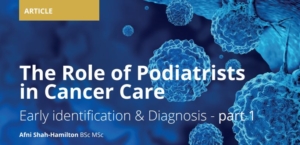When there is a wound, infection or problem with a foot ulcer, a podiatrist has the specialist knowledge to treat it and Tiptoe Podiatry Clinic are proud to specialise in wound care and chemotherapy effects on the feet (see also our specialist cancer related page).
Our services are available to all patients, whether they be an inpatient of a local hospital, a housebound patient, or an outpatient of a department such as Oncology, Vascular, Rheumatology or Diabetes. Patients can be referred via their doctor, nurse or they can simply arrange an appointment themselves.
We deliver evidence based wound care to all patients referred to us and follow the NICE clinical guidelines on the management of the foot.
We provide podiatry treatments for:
- Diabetic ulcers;
- Ischemic/Arterial/ Venous ulcers;
- Pressure ulcers;
- Surgical wounds;
- Chemotherapy induced wounds such as infected/ingrown toenails, fissuring, painful neuropathy, painful skin lesions.
- Dermatology concerns.
Our wound care service places a large emphasis on wound prevention and patient education. An ulcer prevention program is an important part of the care we give particular for those starting on strong doses of chemotherapy. Our services include routine foot care to all our ulcer patients, but are not limited to any of the following:
- trimming, cutting, clipping or debriding of nails;
- paring, trimming or removal of corns and calluses.
Our wound care service promotes early management and identification of risk factors for ulcers and amputations. Early management includes education to increase the patient’s knowledge of foot care, through hygiene awareness; regular monitoring and examination of the feet; and ensuring that protective footwear is worn.
In addition, all of our patients annually receive a comprehensive foot examination and a visual inspection of the patient’s feet is conducted at each visit.
The examination includes:
- assessment of protective sensation;
- foot structure and biomechanics;
- vascular status and skin integrity.
Individuals at high risk are evaluated more frequently. An evaluation report of the patient’s neurological and vascular status is sent to their GP.

